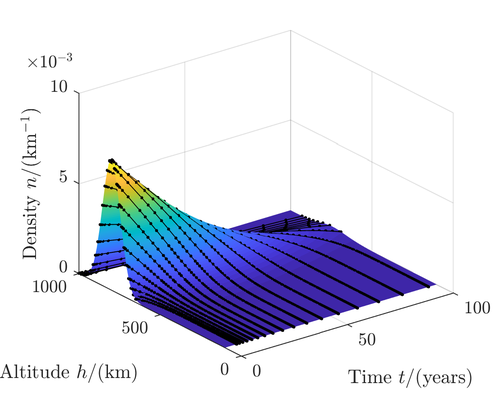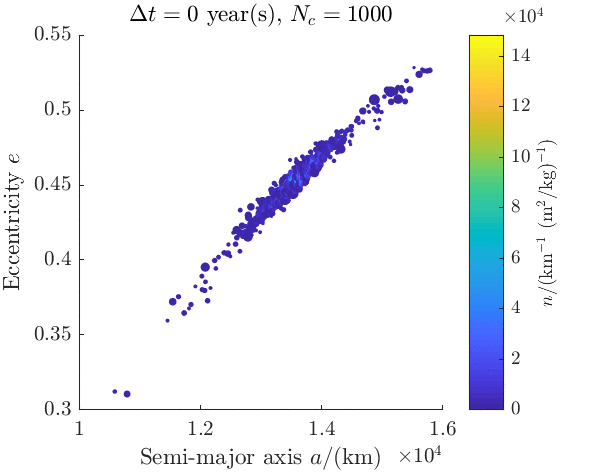
Every year, fragmentations of spacecraft and upper stages add more space debris to Earth bound orbits. Such fragments can pose a risk to other space missions. To better understand the evolution of a cloud of fragments or the entire debris population, models and tools need to be developed. One efficient way to propagate fragmentation clouds in low Earth orbit is through a continuum approach, based on the continuity equation. It describes the cloud as spatial density rather than through individual fragments. This method is extended to work for any major orbital region and incorporate all the principal perturbations using semi-analytical techniques.

Research outcomes
- Derivation of a semi-analytical orbit contraction method, based on the King-Hele method and in combination with a smooth exponential atmosphere model for accurate, analytical estimation of the effects of drag on the orbit, implemented in the PlanODyn suite
- The model allows to find an analytical expression of the Jacobian of the dynamics, which facilitates the calculation of the density evolution along the characteristics of the dynamics in an accurate and quick manner
- Development of two different interpolation schemes to describe the density distribution from the scattered sample points across the whole domain; based on Delaunay triangulation; and based on a Gaussian mixture model
- Application of the density propagation methodology to different fragmentation scenarios in circular and highly eccentric orbits, showing the potential of the method in calculating the collision risk in a computationally less demanding way than traditional Monte Carlo simulations
Scientific production
- S. Frey, C. Colombo, “Transformation of satellite breakup distribution for probabilistic orbital collision hazard analysis,” Journal of Guidance, Control, and Dynamics, Vol. 44, No. 1, 2021, pp. 88-105. https://doi.org/10.2514/1.G004939 (open access)
- S. Frey, “Evolution and hazard analysis of orbital fragmentation continua”, Doctoral thesis, Politecnico di Milano, Supervisors: C. Colombo, S. Lemmens, and H. Krag, 2020. http://hdl.handle.net/10589/165144
- S. Frey, C. Colombo, S. Lemmens, “Application of density-based propagation to fragment clouds using the Starling suite”, First Int’l. Orbital Debris Conf., Sugarland, Houston, TX, USA, 2019. https://re.public.polimi.it/handle/11311/1123138
- S. Frey, C. Colombo, S. Lemmens, “Extension of the King-Hele Orbit Contraction Method for Accurate, Semi-Analytical Propagation of Non-Circular Orbits”, Advances in Space Research, Vol. 64, No. 1, 2019, pp. 1-17. https://doi.org/10.1016/j.asr.2019.03.016. Download dataset: https://doi.org/10.5281/zenodo.3048773
- S. Frey, C. Colombo, S. Lemmens, “Interpolation and Integration of Phase Space Density for Estimation of Fragmentation Cloud Distribution”, In Proceedings of the 29th AAS/AIAA Space Flight Mechanics Meeting, Ka’anapali, HI, USA, 2019. https://re.public.polimi.it/handle/11311/1074833
- S. Frey, C. Colombo, S. Lemmens, “Evolution of Fragmentation Cloud in Highly Eccentric Earth Orbits through Continuum Modelling”, In Proceedings of the 69th International Astronautical Congress, Bremen, Germany, 2018. https://re.public.polimi.it/handle/11311/1066414
- S. Frey, C. Colombo, S. Lemmens, H. Krag, “Evolution of fragmentation cloud in highly eccentric orbit using representative objects”, In Proceedings of the 68th International Astronautical Congress, Adelaide, Australia, 2017. https://re.public.polimi.it/handle/11311/1079360
Advisor
- Camilla Colombo
- Holger Krag
- Stijn Lemmens
Researchers
